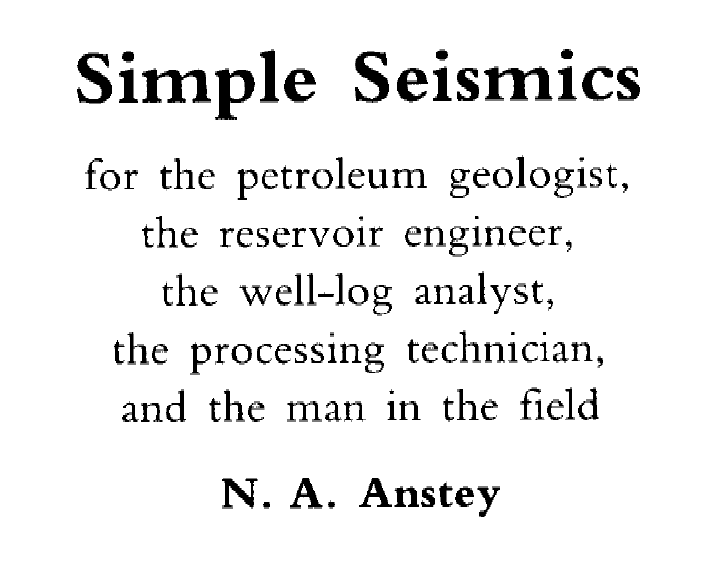

Baird is republishing this wonderful little book. Order your copy of Simple Seismics from Baird Petrophysical: Click Here
To view opening pages: Click Here
About Nigel A. Anstey:
N. A. Anstey"People
are expecting great things from us. So let's go. With care plain, simple
painstaking, conscientious care," Nigel A. Anstey, September 11, 1969
The words are taken from an intercompany memo marking the opening of a new data processing center, of which Nigel was the managing director. The words, admittedly taken out of context, made a profound and lasting impression upon men. The words speak volumes about the nature of the man and the reason that the SEG honors him today with the presentation of its highest award, the Maurice Ewing Medal Award. The words, written for a young eager group of data processors, have echoed time and time again from Nigel's books and presentations to a much larger audience to our entire profession as a whole.
Nigel's career spans 37 years and includes every major division of the seismic exploration method field work, processing, interpretation, and research. After graduation from the University of Bristol in 1948, he worked in the field as observer on field crews in the Middle East and the West Indies for SSL. The realities of the field prevented any hint of "ivory tower" isolation in Nigel's later work.
In 1953, he returned to England as a research geophysicist. During this period, Nigel made substantial contributions to the development of analog magnetic recording and its associated analog processing. This work is reflected in some of his early papers in EAEG's journal, Geophysical Prospecting, and contributed to his election as a Fellow of the Institution of Electronic and Radio Engineers. In 1961, Nigel was coinventor of the magnetic correlator and thus helped usher the Vibroseis system into practical usage. Thus far, he has secured more than 30 patents in his career.
In the late 1950s Nigel addressed the topic of the earth's effects on the seismic wave form. One of his papers, Why all this interest in the shape of the pulse, published in 1957, still serves as a guide to areas of profitable research. In 1959, Nigel published the first explanation of the reinforcing effects of short-path peg-leg multiples on the transmission of the seismic pulse.
Nigel's communication skills were already evident in his early works the well chosen understandable words, the eloquent simple diagrams, the injected wit that charms us while refocusing our attention, and the melding of the geophysical tool and the geologic objective. These trademarks of Nigel's style led to the Conrad Schlumberger Award from the EAEG and the Best Presentation Award from the SEG, both in 1964.
In 1968, Nigel joined Seiscom Delta, Inc., establishing Seiscom Limited in Sevenoaks, Kent, England, and serving as senior vice-president and as director. In the early 1970s, he turned his attention to the area of seismic displays and played a key role by helping introduce the color seismic section into routine use. The publishing of his first book, Seismic Prospecting Instruments, Volume I, and continuing technical contributions resulted in the Kauffman Gold Medal Award in 1972.
In 1973, Nigel served as president of the EAEG. In his Presidential Address, "How do we know we are right?" he said, "And so it seems to many of us that the time has come to strengthen the criterion of geologic plausibility. Further, it seems that this should be part of a broad effort, by geophysicists, to provide internal validation of their conclusions." The statement proved to be a touchstone for his later work and the direction of the industry. The Matson Award from the AAPG in 1974 confirmed Nigel's geologic themes were appreciated by fellow explorationists.
In 1975, Nigel became an independent geophysical consultant, actively involved in exploration, in teaching, and in writing. A series of short courses and a second book, Seismic Interpretation, The Physical Aspects, followed shortly thereafter. In 1976 a basic VSP patent was secured on the use of the downgoing signal to deconvolve the upgoing signal. Further recognition by the SEG came in the form of Honorary Membership in 1977.
Nigel's contributions to the industry continued. Two more books, Seismic Exploration for Sandstone Reservoirs and Simple Seismics, along with the authorship or co-authorship of 15 monographs in a video library training series increased our collective understanding of the seismic method. Of the monographs, Nigel laughingly remarks, there are only 30 more to go! In a recent work, he formalized the concept of three stack array. Nigel's impact on the industry and his communication skills were formally recognized again with his 1983 Distinguished Lecture, "A few things left to do . . ." One has to believe, based on his past accomplishments, that Nigel will substantially contribute to these too.
Nigel stated in a recent letter, "I do take pleasure in writing teaching material which transcends the artificial boundaries between field work, processing, and interpretation; and indeed, the artificial boundaries between geophysics and geology also. If my generation of geophysicists has anything to offer the new generation, as we pass the baton to them, it is perhaps this wide view of the science as a whole."
To his wonderful wife Wendy, his two daughters, and his prized grandchildren, we say thanks for sharing Nigel with us. For we know that "care plain, simple, painstaking, conscientious care" also takes time.
by Ray C. Farrell